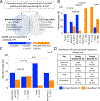Clinical and Genomic Features of Classical and Basal Transcriptional Subtypes in Pancreatic Cancer
- PMID: 39283131
- PMCID: PMC12267046
- DOI: 10.1158/1078-0432.CCR-24-1164
Clinical and Genomic Features of Classical and Basal Transcriptional Subtypes in Pancreatic Cancer
Abstract
Purpose: Transcriptional profiling of pancreatic cancers has defined two main transcriptional subtypes: classical and basal. Initial data suggest shorter survival for patients with basal tumors and differing treatment sensitivity to FOLFIRINOX and gemcitabine plus nab-paclitaxel by transcriptional subtype.
Experimental design: We examined 8,743 patients with RNA sequencing from pancreatic cancers performed at Caris Life Sciences. Classical and basal subtypes were identified using purity independent subtyping algorithm on RNA sequencing, and two cohorts were analyzed: (i) the biomarker cohort included patients with complete molecular profiling data (n = 7,250) and (ii) the outcome cohort included patients with metastatic disease with available survival outcomes (n = 5,335). A total of 3,842 patients were shared between the two cohorts. Kaplan-Meier curves and Cox proportional hazards regression were used to assess patient survival.
Results: In the biomarker cohort, 3,063 tumors (42.2%) were strongly classical (SC) and 2,015 tumors (27.8%) were strongly basal (SB). SC and SB tumors showed strong associations with histologic phenotypes and biopsy sites. SB tumors had higher rates of KRAS, TP53, and ARID1A mutations, lower rates of SMAD4 mutation, and transcriptional evidence of epithelial-mesenchymal transition. Sixty of 77 cases (78%) maintained their transcriptional subtype between temporally and/or spatially disparate lesions. In the outcome cohort, the SB subtype was associated with shorter overall survival time, regardless of whether they received FOLFIRINOX or gemcitabine plus nab-paclitaxel as first-line chemotherapy. The mutant KRAS allele type was prognostic of outcomes; however, this impact was restricted to SC tumors, whereas all mutant KRAS alleles had similarly poor outcomes in SB tumors.
Conclusions: The SB subtype is a strong independent predictor of worse outcomes, regardless of the up-front chemotherapy regimen used. Clinical trials should further investigate pancreatic cancer transcriptional subtypes as a prognostic and predictive biomarker.
©2024 American Association for Cancer Research.
Figures




References
-
- Aguirre AJ, Nowak JA, Camarda ND, Moffitt RA, Ghazani AA, Hazar-Rethinam M, et al. Real-time Genomic Characterization of Advanced Pancreatic Cancer to Enable Precision Medicine. Cancer Discov 2018;8(9):1096–111 doi 10.1158/2159-8290.CD-18-0275. - DOI - PMC - PubMed
MeSH terms
Substances
Grants and funding
LinkOut - more resources
Full Text Sources
Medical
Research Materials
Miscellaneous

